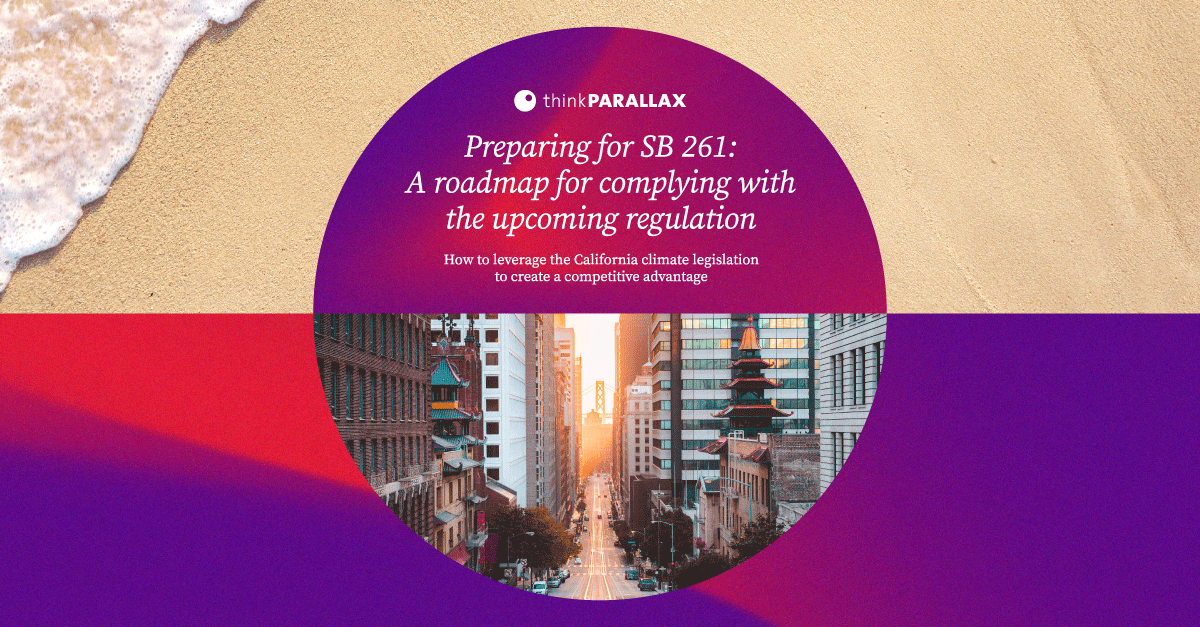Join our upcoming webinar to learn what SB 253 and SB 261 mean for your business.
SB 261 isn’t just another regulation—it’s a clear signal that climate-related risk is now business-critical. Compliance may be mandatory, but the implications go far beyond avoiding penalties. As Sheila Ongie, Head of Sustainability at thinkPARALLAX, puts it:
“The real cost of inaction extends beyond fines. It’s reputational, operational, and strategic. Companies that delay climate risk planning aren’t just risking penalties — they’re risking irrelevance.”
If your company earns more than $500 million annually and does business in California, you have until January 1, 2026, to comply with the state’s Climate-Related Financial Risk Act. This groundbreaking legislation requires climate-related financial risk disclosures aligned with the Task Force on Climate-Related Financial Disclosures (TCFD) framework — or face penalties of up to $50,000 per reporting year.
But as Ongie points out, the real opportunity lies in using SB 261 as a catalyst for smarter strategy and long-term resilience.
That’s why we created Preparing for SB 261: A Roadmap for Complying with the Upcoming Regulation. This guide goes beyond compliance, giving you the tools to conduct a climate risk gap assessment, identify priorities, and build a more competitive, future-ready business.
What’s inside and why it's essential reading
This step-by-step roadmap will help you:
-
Clarify exactly what SB 261 entails and confirm if your company is within scope
-
Collect and analyze climate-related risk and opportunity data across your entire value chain
-
Understand the differences between physical and transition risks — and why addressing both is critical
-
Turn risk assessments into actionable strategic priorities
-
Confidently create your SB 261-aligned climate disclosure to avoid regulatory penalties and enhance stakeholder trust
Why you must act now — not later
SB 261 isn't just another compliance requirement — it’s a call for immediate, strategic action.
From devastating floods and wildfires disrupting operations to changing regulations and investor expectations, climate-related financial risks are now a tangible threat to your bottom line.
Major global markets, including the EU and the U.K., are already enforcing similar climate disclosure mandates.
Investors, customers, and stakeholders now demand transparency. Businesses that proactively disclose climate risks and demonstrate genuine strategic action will be rewarded with greater trust and competitive advantage.
Your SB 261 compliance roadmap at a glance:
-
Step 1: Research and data collection
-
Step 2: Risk and opportunity assessment
-
Step 3: Climate scenario analysis
-
Step 4: Prioritizing strategic actions
-
Step 5: Disclosure aligned with TCFD
With the right roadmap, compliance is more than achievable — it’s a pathway to resilience.
The takeaway
Your climate disclosures under SB 261 can demonstrate your company’s commitment to social responsibility, climate resilience, and business innovation. By proactively addressing climate risks, you're not just avoiding fines — you're positioning your company as a forward-thinking leader.
Next steps:
SB 261 is approaching. Climate risks are real. The strategic opportunity is immense.
Don't wait until it's too late. Download your copy of the SB 261 preparation guide and start building your climate-resilient future. Let’s build resilience — together.




.png)


